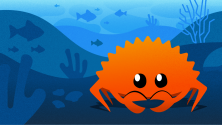Rust is consistently voted one of the languages people most want to learn. In 2022, Opensource.com had a few articles to help you get started.
Rust is a fairly new language, but it's grown quickly. The general excitement about it goes beyond interest in a new language to try. Rust has genuinely useful features, like the ability to allocate data to the heap (instead of the stack) using the Box data type. There's no separate garbage collection required, and you don't have to manually manage memory yourself. Additionally, the Crate.io infrastructure for library management and installation makes it easy to find and use functions contributed by the Rust community.
Install the toolchain
There's a lot to be excited about when looking into learning Rust, but it is a complex language and it can be intimidating. Programming is a practical discipline. To learn a language, it's not enough to read about it and ponder it. You have to use it eventually. If you're curious about Rust but haven't written any Rust code yet, then take the first step in learning Rust by installing the toolchain.
Debugging Rust
The best way to understand complicated systems is to understand how they break down. The Rust team has you covered with an example Rust application to debug.
Concurrency in Rust
Rust's "fearless concurrency" is sometimes interpreted to be about threads. This is not wrong: Rust's concurrency model does make threaded code easier to write and understand. But that's not all it can do! Another way to get concurrency is to use async code. Rust's async primitives are powerful, as Stephan Avenwedde's article Asynchronous programming in Rust makes clear.
Have you tried Rust?
Have you tried Rust yet? If not, take some time to review these articles and experiment. Let us know what you think in the comments.








Comments are closed.